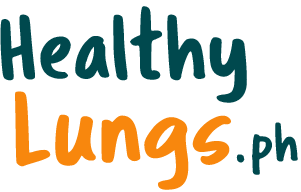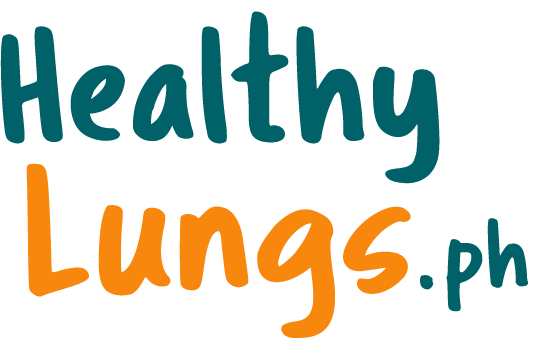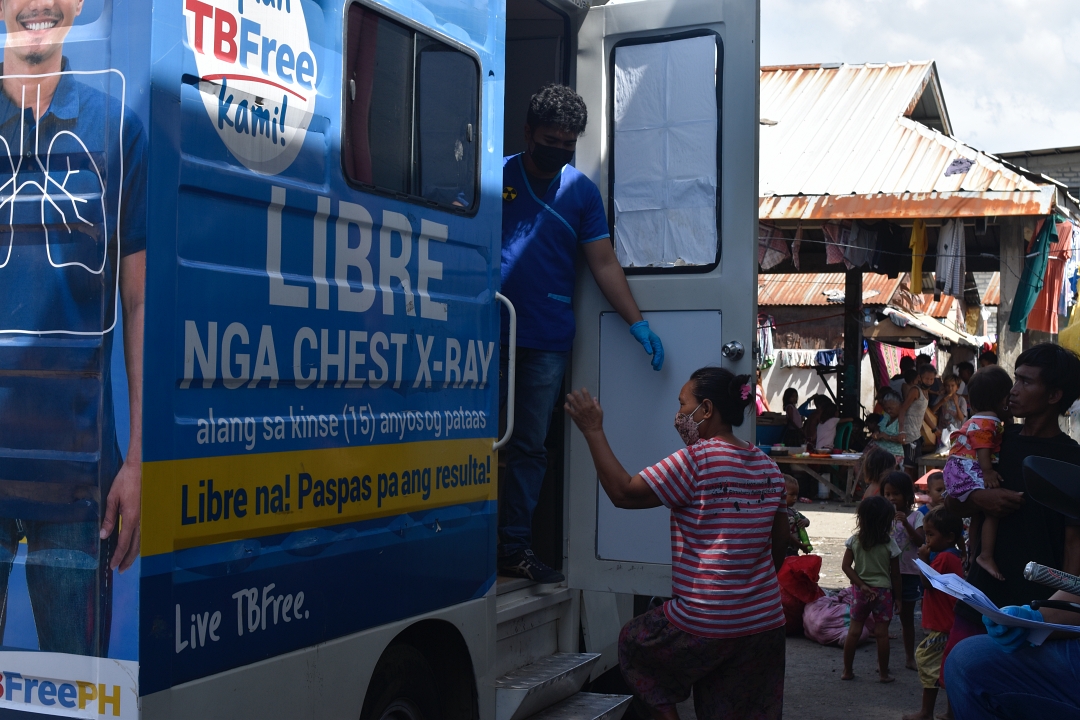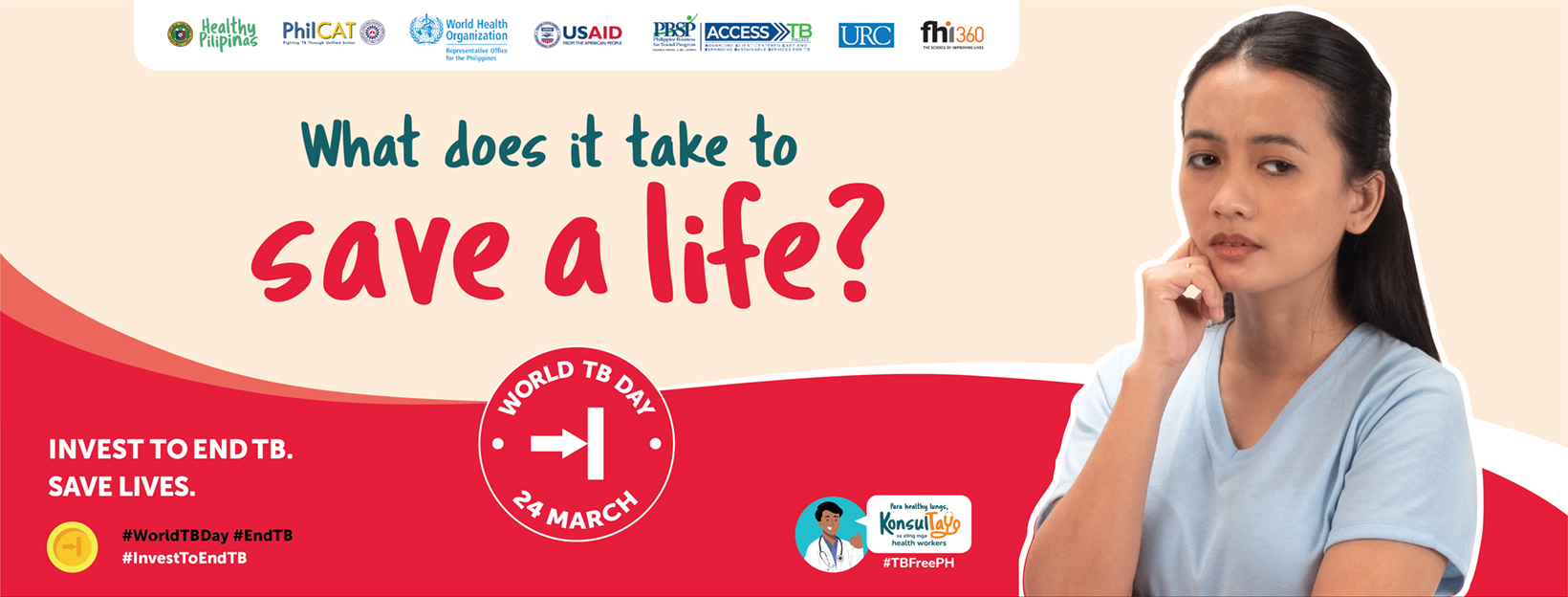- Details
- Written by TBFREEPH
Itwas a sweltering July day. Neri Murias, 67, gingerly climbed over the gate blocking the doorway of the one-room home he shared with his wife, two children, and three grandchildren, trying not to let the dogs out. Roosters crowed loudly and children chased each other along the narrow path as Neri wove his way through the densely populated neighborhood to the main road, dodging puddles from the previous night’s heavy rain.
At the main road, Neri lifted his frail body into the driver’s seat of his jeepney, an open-air jeep that serves as a primary form of public transportation in the Philippines. He put his keys in the ignition and the engine roared to life, drowning out the sound of his cough.
Neri poses in the house he shares with his wife, two children, and three grandchildren. / Christina Butler, USAID
As Neri plied his regular route along the congested streets of Manila, stopping intermittently to let passengers on and off, his cough intensified. Over the next month, it only got worse.
“I experienced these coughing fits when I was driving,” remembered Neri. “They wouldn’t stop. Sometimes, I’d see blood.”
His body got weaker. Neri lost his appetite and began losing weight. He struggled to breathe. Concerned he might have COVID-19, Neri visited a USAID-supported health clinic to get tested.
“I really wasn’t feeling well,” said Neri. “I decided to stop driving and get myself checked.”
Neri visited the Delpan Quarantine Facility, a pilot site for USAID’s joint tuberculosis (TB) and COVID-19 screening and testing program. This program allows patients to get tested for TB and COVID-19 simultaneously, helping them receive accurate diagnosis to get the treatment they need.
Dr. Agnes Paderanga speaks with Neri about his TB treatment regimen. / Christina Butler, USAID
During the COVID-19 pandemic, TB prevention and control efforts in the Philippines dropped dramatically. Many of the country’s health workers were redirected to COVID-19 response, and fewer Filipinos visited health facilities unless they had an urgent health problem. The joint screening and testing program is USAID’s latest effort to actively find TB cases in the Philippines.
The Philippines has the third-highest TB prevalence rate in the world, with 1 million Filipinos having active TB. Although it is a highly curable disease, it is the number one killer among all infectious diseases in the Philippines. In 2020, 31,000 Filipinos lost their lives to TB. In that same year, nearly 10,000 died of COVID-19 among the nearly half-million confirmed cases.
“During the pandemic, people tend to think that if they have any sort of cough, it must be COVID,” said Dr. Agnes Paderanga, physician-in-charge at San Nicolas Health Center.
“But coughing is also a symptom of TB. For TB patients, however, coughing lasts longer, and they experience other symptoms like unexplained weight loss, loss of appetite, and night sweats.”
Although Neri originally only went in for a COVID-19 test, healthcare workers recognized that Neri’s symptoms could be TB and suggested he also submit a phlegm sample. Neri tested negative for COVID-19, but positive for TB.
“Everything changed when I received this diagnosis,” Neri remembered. “It was such a difficult time for me.”
Neri was referred to the nearby San Nicolas Health Center for treatment. USAID-trained healthcare workers assured him that once on proper medication, he would become less infectious after only a couple of weeks of treatment. After completing his full six-month regimen, he would be TB-free.
Every week, Neri’s son went to San Nicolas to pick up medication for his father. Neri diligently took his medication and, over time, started to show improvement.
“When I first took my medicines at night, my cough would be gone the next day. Because I consistently took my meds every day, my cough dissipated,” he said.
Amid the COVID-19 pandemic, USAID supported several initiatives to ensure TB services remain available to Filipinos. In addition to piloting the joint screening for TB and COVID, USAID has also supported the private sector to make TB tests more affordable and partnered with local leaders to generate close to $750,000 (42 million pesos) to fight TB.
USAID also equipped the Department of Health and local government partners with $2.3 million (130 million pesos) worth of innovative tools for TB detection, diagnosis, treatment, and prevention. As a result of these interventions, more than 312,000 people received life-saving TB treatment in 2021 — including Neri.
These numbers are still below the national target, but each number represents another chance at life. For Neri, TB treatment gave him another chance to hug his children and see his wife smile.
It is this mindset that keeps healthcare workers like Dr. Paderanga motivated despite the challenges of the pandemic.
“I always think of each patient as my son, as my daughter, as a friend, as a family member,” said Dr. Paderanga.
“When you love someone, you do everything you can to save them. No holds barred. We, as health practitioners, must see patients as people, and not as their disease.”
Neri’s daughter meets him on the steps of San Nicolas and hugs him tightly. Thanks to USAID, the local government, and healthcare heroes like Dr. Paderanga, her father has fully recovered.
“I have immense gratitude for those who’ve helped me get tested and treated,” said Neri. “Whatever health problem you’re experiencing, you should get yourself checked.”
Link to the original article here: Neri’s Journey. USAID supports innovative methods to… | by USAID | U.S. Agency for International Development | Aug, 2022 | Medium
- Details
- Written by TBFREEPH
Experts and officials from the Department of Health (DOH), Climate Change Commission, and the Department of Environment and Natural Resources (DENR), and the United States Agency for International Development (USAID),called for concerted efforts to improve air quality in the Philippines and mitigate its effects on lung health.
In a webinar organized by non-profit human development organization FHI 360, Climate Change Commissioner Atty. Rachel Anne Herrera pointed out the impact of poor air quality on Filipinos and the country’s economy. She also discussed the need to talk the same language among concerned agencies and “break down silos” towards developing green technologies necessary for climate-resilient communities and health facilities, with the help of the private sector.
“An estimated 66,000 Filipinos die every year due to poor air quality and the economic cost of ambient air pollution is 4.5 trillion pesos, roughly equivalent to 87 billion US dollars. And this is 23 percent of the country's GDP (gross domestic product) in 2019,” said Herrera, citing a study by the Institute for Climate and Sustainable Cities and the Center for Research on Energy and Clean Air.
Dr. Rosalind Vianzon of the DOH-Health Promotion Bureau highlighted the importance of research that will guide climate and health professionals in working together. She identified crucial factors like advocacy, healthy settings, integration and partnerships, and innovation and technology.
Dr. Kendra Chittenden, senior infectious disease advisor of USAID Bureau for Asia, echoed a similar point on research, specifically one that will show the impact of air quality on lung health as “immensely important.”
“Looking at communities and taking real-life situations in trying to look at the impact of air pollution when there are so many other factors that drive people’s health is very challenging,” said Dr. Chittenden. “Countries, like the Philippines across Asia, have the capability of such strong research organizations as the academic sector is working really closely with the ministries of health and you have this sort of multisectoral approach working with climate change and environmental experts. So it’s a really great opportunity for the Philippines to continue to contribute to this.”
When asked about concrete actions that the government is taking to address the problem, Atty. Herrera of the Climate Change Commission said legislators are eyeing to update the Clean Air Act of 1999. Several national agencies are also working on a framework to strengthen the health sector and in turn “protect the most vulnerable” in society. She added that the commission continues to regularly train local government units to identify sources of greenhouse gas within their jurisdiction and address them efficiently.
Michelle Lang-Alli, director of USAID Philippines’ Office of Health, also pushed for “very strong and sustained collaborative partnership towards addressing environmental issues” that would support the elimination of tuberculosis or TB in the Philippines. “Broad-scale evidence has shown the significant association between ambient air pollutants and the development of TB. However, the impact of air quality on the risk of TB in the Philippines is still poorly understood.”
Ms. Alli added, “Through our decades of partnership, we have [made] significant strides in TB control and improving the health of Filipinos nationwide. However, Filipinos would continue to suffer and [be] more susceptible to TB if we allow the continued deterioration of the quality of the air that we breathe.”
To learn more about the climate and its impact on health, like and follow FHI 360 on Facebook and Twitter. Explore the organization’s efforts in improving lives and how to become a partner at its website fhi360.org.
###
- Details
- Written by TBFREEPH
Manila and non-Manila residents scheduled for free RT-PCR may now also avail of the free chest X-ray being offered by the City of Manila as it starts implementing the country’s first-ever bidirectional screening and testing for COVID-19 and Tuberculosis (TB) through the swabbing and isolation facilities in Sta. Ana Hospital and Delpan Evacuation Center Quarantine/Isolation Facility, an initiative that started on August 25, 2021 and September 02, 2021 respectively. Meanwhile, Manila COVID-19 Field Hospital (MCFH) has started sputum collection for rapid TB diagnostic testing among admitted individuals since the first week of September.
- Details
- Written by TBFREEPH
Amid the COVID-19 pandemic, USAID implemented several initiatives to boost the Philippine government’s fight against this dreaded disease.
Ryan Washburn, USAID Mission Director to the Philippines, Pacific Islands and Mongolia
Read how USAID commits to make more investments towards ending TB on World TB Day 2022.
- Details
- Written by TBFREEPH
The Department of Health reported 311,000 TB cases in 2021 compared to 263,000 cases in 2020, based on the national TB registry.
- Details
- Written by TBFREEPH
Together, let’s invest to end TB and save lives.
2022 is a critical year in the global fight to end TB as we count down to reach our targets.
COVID-19 response and catastrophic gaps in funding continue to threaten our progress in eradicating TB. Less than half of the promised US$ 15 billion annual funding has been delivered. The case for investing in TB, thus, is foremost financial. Yet, the investment of hard work, resolve, emotion, and energy prove just as important as the monetary assets needed to end this preventable and curable disease.








